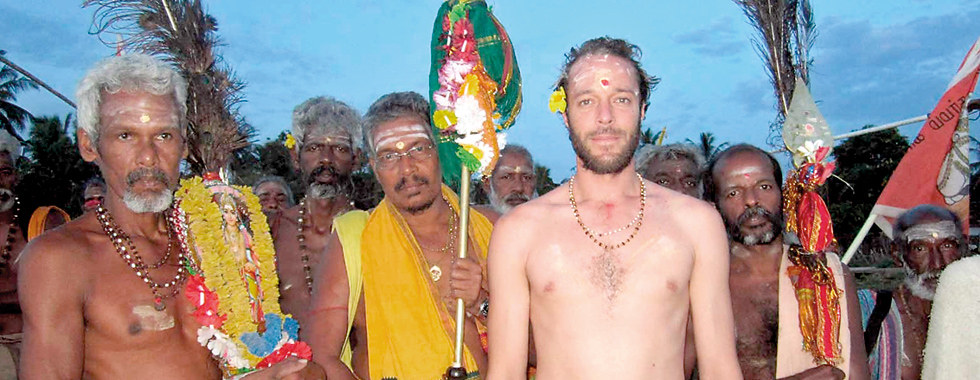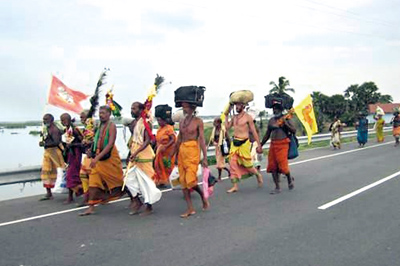Pada Yatra: Love, devotion and humility
It is an hour before dawn and I find myself passing through paddy fields of eastern Sri Lanka as if on a boat drifting through the night. Shouts of ‘Haro Hara’ (‘Hallelujah‘) from onlookers wafting through the darkness are reminiscent of olden days when bystanders and loved ones alike wished the traveller bon voyage.
Our ‘boat’ is not made of iron or timber although it is both sturdy and strong. Our vessel consists of 54 devotees of Skanda-Kumara, the youthful god of war, wisdom and poetry or, as Tamil devotees call Him, Murugan (‘Tender One’).

One among the pilgrims: Ben Vecchiet on the Pada Yatra
The devotees are drawn onwards, as countless others have before them over the past few millennia, in step to mantras and songs. Our destination is Lord Murugan’s jungle redoubt Kataragama in the far Southeast. I use the word ‘drawn’ because our nade or kuttam (party of pilgrims) feels ‘drawn’ into a mystical or mythological vortex that surrounds this mysterious deity and His abode.
I am accompanying my fellow pilgrims in order to understand their faith in Murugan and to experience not only the trials and tribulations but also the awe and amazement that Pada Yatra, the annual pilgrimage from Jaffna to Kataragama, instils in its stalwart participants.
While the pilgrims usually cover 15-25 kilometres a day, the authorities this year in an unprecedented move, pushed back the Kataragama Esala festival flag-hoisting date, and therefore our arrival date, by a full month. This caused much confusion, as many of the pilgrims have agricultural or employment responsibilities at home.
In response to the delay, a week before my arrival, those devotees who had responsibilities decide to return home. The remaining devotees bide their time along the traditional coastal route walking shorter distances and spending more days at rural resting halts.
While walking is an essential part of the pilgrimage, walking takes only a fraction of the day, up to five hours. The remainder of the day is spent praying, bathing, eating, and delving into philosophical conversations or idle gossip.
While every temple is sacred, two are noteworthy.
Mandur Murugan miracle
During afternoon siesta time a handful of us are ushered into the Mandur shrine by the pujari who, to our surprise, displays a selection of antique muskets and swords. He recounts a story that has been passed down for eight generations. The weaponry comes alive as he recounts the story of Portuguese soldiers who tried to loot the temple.

On the road: The pilgrims’ progress. Pix by K. Vinayagamoorthy
The priests of the day retreated inside the sanctum sanctorum for protection. Their only hope lay in their faith that Murugan would intervene. Suddenly, as if in response to their prayers, a swarm of wasps attacked the soldiers who dropped their weapons and fled for their lives. The weapons have remained in the temple ever since as a reminder of Murugan’s power.
Tirukkovil
After leaving Mandur, a pleasant two weeks pass, slowly heading South enjoying the almost celebratory dana, or generosity, of villagers along the way. We reach the mythological and historically important Tirukkovil Citira Velayuta Cuvami Temple.
According to legend, the site once housed a Siva temple erected by King Ravana. Veddahs also believed one of the rays from Murugan’s violent splitting of Vakura Hill landed here. Archaeologists date the vimanam or dome above the sanctum sanctorum to the 13th Century.
As the kuttam headed South we encounter military assistance thrice and on each of these occasions it is a sheer delight to receive assistance and discuss issues involved within the ‘new era’ of Sinhala-Tamil relations. Boots came off in the temple, the quality of the food rose to a level rarely seen by the humble pilgrims and there was sincere interest in their progress and well being.
Twice I had discussions with Army officers. I was taken by the wisdom, sincerity and humility of both of these officers and the way that their own personal characteristics ran through the ranks of their soldiers.
Wisdom
Weeks have passed but I still find myself asking endless questions. Yet my knowledge is naught compared to the wisdom I heard from the youngest member of our party, eight time veteran of the Pada Yatra, 26-year-old Arnden.
I asked Arnden why his devotion to Murugan is so important. What did he see in Murugan, what did he want from the benevolent god?
The young man gave me the most humble, direct and meaningful answer of the entire journey, and simply said, “Murugan love”.
My eyes water as I write those two words even weeks later.
With Arnden’s wisdom reverberating through my mind I began observing the devotees and the sacred journey we were on through new eyes. My approach up until then had been too obsessed with facts and figures to notice what was truly happening.
I became aware that pilgrims do not walk the Pada Yatra to educate themselves. They do not walk for social unity. These aspects of the Pada Yatra are simply secondary outcomes.
I understood finally that the ancient tradition of the Kataragama Pada Yatra exudes its mystery, magic and tremendous enthusiasm among the pilgrims for one reason, and that is simply, the deep-seated devotion to Lord Kataragama. Yes, the reasons for participation may vary, be it asking for charity, repaying debts for Murugan’s benevolence in the past, or simply to express, as Arnden was, one’s whole-hearted love for God.
This, I came to understand, is the common foundation of all Kataragama pilgrims. Regardless of their official religion, the devotee feels drawn out of love to the God who dwells in Kataragama.
(Ben Vecchiet is a student of anthropology at Deakin University, Geelong, Australia)
Follow @timesonlinelk
comments powered by Disqus


